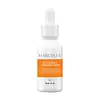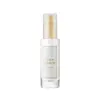What's inside
What's inside
 Key Ingredients
Key Ingredients

 Benefits
Benefits

 Concerns
Concerns

No concerns
 Ingredients Side-by-side
Ingredients Side-by-side

Water
Skin Conditioning3-O-Ethyl Ascorbic Acid
Skin ConditioningDimethicone
EmollientPropanediol
SolventGlycerin
HumectantSodium Citrate
BufferingDimethiconol
EmollientCitric Acid
BufferingLactobacillus Ferment
Skin Conditioning1,2-Hexanediol
Skin ConditioningPolyacrylate Crosspolymer-6
Emulsion StabilisingMaltodextrin
AbsorbentHydroxyethyl Acrylate/Sodium Acryloyldimethyl Taurate Copolymer
Emulsion StabilisingSqualane
EmollientSodium Gluconate
Skin ConditioningCaprylhydroxamic Acid
Polysorbate 60
EmulsifyingT-Butyl Alcohol
PerfumingSorbitan Isostearate
EmulsifyingWater, 3-O-Ethyl Ascorbic Acid, Dimethicone, Propanediol, Glycerin, Sodium Citrate, Dimethiconol, Citric Acid, Lactobacillus Ferment, 1,2-Hexanediol, Polyacrylate Crosspolymer-6, Maltodextrin, Hydroxyethyl Acrylate/Sodium Acryloyldimethyl Taurate Copolymer, Squalane, Sodium Gluconate, Caprylhydroxamic Acid, Polysorbate 60, T-Butyl Alcohol, Sorbitan Isostearate
Aspergillus/Rice Germ Ferment Extract Filtrate 73%
EmollientPropanediol
SolventGlycerin
HumectantMethylpropanediol
SolventCyclopentasiloxane
EmollientNiacinamide
SmoothingCaprylyl Methicone
Skin ConditioningWater
Skin ConditioningCyclohexasiloxane
Emollient1,2-Hexanediol
Skin ConditioningSqualane
EmollientBetaine
HumectantC12-14 Pareth-12
EmulsifyingAmmonium Acryloyldimethyltaurate/Vp Copolymer
Panthenol
Skin ConditioningC30-45 Alkyl Cetearyl Dimethicone Crosspolymer
EmollientEthylhexylglycerin
Skin ConditioningAllantoin
Skin ConditioningXanthan Gum
EmulsifyingDipotassium Glycyrrhizate
HumectantAdenosine
Skin ConditioningDisodium EDTA
Pentylene Glycol
Skin ConditioningHydrolyzed Hyaluronic Acid
HumectantAlpha-Glucan Oligosaccharide
CleansingSodium Hyaluronate
HumectantMadecassoside
AntioxidantPortulaca Oleracea Extract
Skin ConditioningHydroxypropyl Cyclodextrin
MaskingGlutathione
Aspergillus/Rice Germ Ferment Extract Filtrate 73%, Propanediol, Glycerin, Methylpropanediol, Cyclopentasiloxane, Niacinamide, Caprylyl Methicone, Water, Cyclohexasiloxane, 1,2-Hexanediol, Squalane, Betaine, C12-14 Pareth-12, Ammonium Acryloyldimethyltaurate/Vp Copolymer, Panthenol, C30-45 Alkyl Cetearyl Dimethicone Crosspolymer, Ethylhexylglycerin, Allantoin, Xanthan Gum, Dipotassium Glycyrrhizate, Adenosine, Disodium EDTA, Pentylene Glycol, Hydrolyzed Hyaluronic Acid, Alpha-Glucan Oligosaccharide, Sodium Hyaluronate, Madecassoside, Portulaca Oleracea Extract, Hydroxypropyl Cyclodextrin, Glutathione
 Reviews
Reviews

Ingredients Explained
These ingredients are found in both products.
Ingredients higher up in an ingredient list are typically present in a larger amount.
1,2-Hexanediol is a synthetic liquid and another multi-functional powerhouse.
It is a:
- Humectant, drawing moisture into the skin
- Emollient, helping to soften skin
- Solvent, dispersing and stabilizing formulas
- Preservative booster, enhancing the antimicrobial activity of other preservatives
Glycerin is already naturally found in your skin. It helps moisturize and protect your skin.
A study from 2016 found glycerin to be more effective as a humectant than AHAs and hyaluronic acid.
As a humectant, it helps the skin stay hydrated by pulling moisture to your skin. The low molecular weight of glycerin allows it to pull moisture into the deeper layers of your skin.
Hydrated skin improves your skin barrier; Your skin barrier helps protect against irritants and bacteria.
Glycerin has also been found to have antimicrobial and antiviral properties. Due to these properties, glycerin is often used in wound and burn treatments.
In cosmetics, glycerin is usually derived from plants such as soybean or palm. However, it can also be sourced from animals, such as tallow or animal fat.
This ingredient is organic, colorless, odorless, and non-toxic.
Glycerin is the name for this ingredient in American English. British English uses Glycerol/Glycerine.
Learn more about GlycerinPropanediol is an all-star ingredient. It softens, hydrates, and smooths the skin.
It’s often used to:
Propanediol is not likely to cause sensitivity and considered safe to use. It is derived from corn or petroleum with a clear color and no scent.
Learn more about PropanediolSqualane is an emollient that helps the skin hold onto moisture. It's an oily liquid that occurs naturally in certain types of fish and plant oils.
Because squalane boosts hydration in the skin, it also comes with plenty of benefits: it is an antioxidant and can help fight free radicals and skin damage. Squalane is also found to have a detoxifying effect when applied.
Squalane comes from squalene, which occurs naturally within the sebum of our skin. It is one of the oils our skin produces to keep itself hydrated. Squalane is the hydrogenated version of squalene and has a longer shelf life.
Research shows that squalane is non-irritating (even at 100% concentration).
In general, it's a fantastic ingredient. It does a great job at hydrating the skin, and it's suitable for those with sensitive skin.
The source of squalane may impact malassezia / fungal acne. This is because olive oil derived squalane can contain impurities such as fatty acids and plant waxes. Sugarcane derived squalane is recommended for anyone with malassezia concerns.
Is squalane vegan?
This depends on the source. Squalane can be derived from both plants and animals. Most squalane used in skincare comes from plants.
Please note: the source of squalane is only known if disclosed by the brand. We recommend reaching out to the brand if you have any questions about their squalane.
Read more about squalene with an "e".
Is squalane an oil?
Squalane is often called an oil, but it’s technically not; it’s a hydrocarbon, meaning it’s only made of carbon and hydrogen, unlike true oils which are triglycerides made of fatty acids and glycerol.
The term “oil-free” isn’t regulated, so companies can define it however they want. Some exclude all oils, while others just avoid mineral oil or comedogenic oils.
While some people avoid oils thinking they cause breakouts, the right kind of oil (or oil-like ingredient like squalane) can actually help balance and hydrate your skin. It’s worth testing out simple oils or squalane to see what works best for your skin.
Learn more about SqualaneWater. It's the most common cosmetic ingredient of all. You'll usually see it at the top of ingredient lists, meaning that it makes up the largest part of the product.
So why is it so popular? Water most often acts as a solvent - this means that it helps dissolve other ingredients into the formulation.
You'll also recognize water as that liquid we all need to stay alive. If you see this, drink a glass of water. Stay hydrated!
Learn more about Water